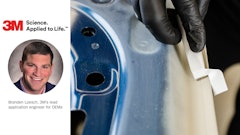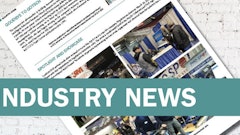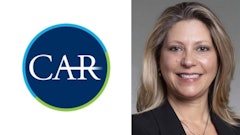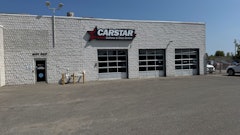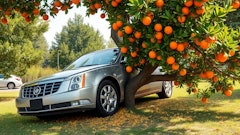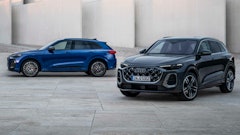
President and CEO of LKQ, Dominick Zarcone.
By Jeff Sanford
Toronto, Ontario — May 1, 2018 — In this week’s Tuesday Ticker, LKQ, Axalat, Akzo and Sherwin Williams report earnings, GM launches a lawsuit against AutoCanada over recent U.S. acquisition and much, much more.
Publicly-traded companies are reporting first quarter earnings this week. It seems most of the companies serving the collision repair sector generated some very solid revenues in the quarter.
LKQ
Auto parts recycler LKQ reported record revenue in the first quarter of 2018, with $2.7 billion. That number reflects a 16 percent increase over the $2.34 billion recorded in the first quarter of last year. Total growth in revenue from parts and services on a global basis came in at 3.7 percent with North American operations, “leading the charge,” according to LKQ CEO Dominick Zarcone, speaking on a conference call held to announce the results. “As mentioned in the Q4 call, very few companies in our sector are generating organic growth at this level,” he said. “Total parts and services revenue for our North American segment grew 8.6 percent during the first quarter of 2018 compared to the first quarter last year. Organic revenue growth for parts and services for our North American segment during the quarter was 6.5 percent, well ahead of expectations. We clearly started the year on a high note in North America, especially when you consider that according to CCC Information Services, collision and liability related auto claims on a national basis were only up 0.8 percent in the first quarter, although there were significant regional differences. According to the CCC data, the traditional Snow Belt states like Illinois, Michigan, Ohio, Pennsylvania, New York and Massachusetts, all experienced material growth in repairable claims according to Zarcone, while states like Washington, California, Texas, Georgia and Florida saw year-over-year declines in repairable claims. “Our revenue largely tracked these regional differences with the Midwest, Northeast and Canadian regions performing extremely strong, while the revenue growth in the South, East and the West was more tempered. Clearly, Mother Nature helped the cause in some of our larger regions. That said, the 6.5 percent organic growth far outpaced the CCC data supporting our view that we continue to gain market share,” said Zarcone. “Also, according to the U.S. Department of Transportation, our performance in Q1 was achieved, while miles driven in the United States were down 0.1 percent on a nationwide basis in February, although like the claims data, there were significant regional differences. Organic growth for the aftermarket parts outstripped that of salvage parts, as the repair shops were looking to improve cycle times given the increased volume of work they were processing.” During the quarter LKQ acquired just one aftermarket radiator distributor in Tennessee, a bit of a slowdown from recent quarters when LKQ made some major acquisitions. “We tempered the volume of our acquisitions primarily to digest what we had acquired in 2017, but [we are] not closing the door on attractive acquisition opportunities,” said Zarcone. Record revenues aside LKQ did realize a reduction in margins (profitability). “Starting with North America, gross margins during the first quarter were 43.3 percent, down 110 basis points over the 44.4 percent reported last year. The aftermarket business represented about 70 basis points of the decline due to several factors. Firstly, rising costs for our supplies and commodities such as sheet metal and resin and ocean freight resulted in higher costs for our inventory. Our net selling prices, however, did not increase to match the higher inventory costs. Efforts are underway to redress this issue on a location, district and region level to offset this headwind,” said Zarcone. “Secondly, a large part of the organic growth we experienced came through products such as automotive batteries, owing to the cold winter and certified OE parts. Both are lower margin products, which diluted the overall margin profile relative to the prior year. Thirdly, our self-serve business also contributed to the lower margin percentage, which initially seems unusual given this rising scrap prices. Parts revenue tends to not grow significantly when car costs rise due to higher scrap prices and create a dilutive effect on the gross margin percentage.” Overall, overhead expenses were up 90 basis points (0.9 percent) as a result of freight, personnel and vehicle costs. “With the high level of sales growth in the quarter, we had to rely on more third-party freight and vehicle rentals to maintain service levels. Like many companies, we too are seeing third-party freight cost rise with driver shortages, wage inflation and higher fuel costs. Weather impacted certain regions such as the Northeast and Midwest, which experienced strong revenue growth, though this came at a price as we had to bring on expensive temp labor and incur overtime to keep up with demand. The premium for temp labor and overtime contributed to an increase in personnel costs outpacing revenue growth. Training is underway on a variety of fronts to address these headwinds.“ Scrap have been rising of late. And that’s going to be good news for recyclers. For LKQ the company realized an increase in prices for scrap steel of 37 percent over the comparable quarter last year and up 21 percent from Q4 of 2017. “We saw a $13 million positive impact on profitability owing to scrap prices, which was $7 million higher than the benefit we experienced in Q1 of 2017,” said Zarcone. The company did miss hitting analyst expectations concerning earnings per share (EPS). Wall Street analysts were expecting EPS of USD $0.58. The company posted EPS of USD $0.55. The unexpected increases in the cost of doing business at LKQ saw analysts at William Blair brokerage adjust their expected full year 2018 EPS to $2.25, down from $2.35, a 4 percent decline.
Axalta
Major American paint maker Axalta also reported Q1 numbers this week. The company beat analysts estimates for EPS by a solid three cents. EPS in the first quarter came in at USD $0.27. Total revenue was USD $1.17 billion, an increase of 15.8 percent from the same period a year earlier. That number beat Wall Street estimates by USD $20 million. In a conference call the CEO Charles Shaver said, “Overall, our quarterly results were slightly better than we have previously projected, including both ongoing strong organic growth in industrial, continued solid performance in commercial vehicle, highlighted by the robust North America heavy duty truck market and welcome benefit from incremental currency tailwinds. As expected, raw material cost continues to inflate with a particularly notable comparison in Q1 versus last year, given that raw materials were still a tailwind to reported results in Q1 2017. With that context, we’ve also begun to make progress, both in price offsets as well as accelerating cost reduction to meet this input cost challenge.” Margins at Axalta declined slightly to 18.9 percent from 20.2 percent due to ongoing raw material inflation. “We continue to target mid-single digit growth for the year. We are gaining market share and expect to see favorable growth comparisons in the second half of the year. Volumes were broadly stable with ongoing modest growth in North America offset by flatter trends for the quarter in other regions. Auto production globally appears to be steady with notable ongoing strength in North America standing out relative to more cautious predictions that we have made for 2018 for the region. We continue to expect flat to low single digit growth in auto production globally in 2018 and slight outperformance versus the industry for Axalta. Commercial vehicle posted healthy net sales growth of 8 percent and 3 percent constant currency growth. Volume growth was witnessed again in nearly all regions, led by continued healthy truck demand in North America and elsewhere,” said Shaver. The company spent USD $105 million in the first quarter on acquisitions with the largest portion going to an internalized refinish colour matching technology platform. “Additionally, we repurchased very little stock in the first quarter, but have devoted additional capital to repurchases here in April. We plan to continue to be opportunistic with share repurchases this year with an expected offset to our share dilution from stock reinvesting as a minimum allocation target. Regarding operating highlights across Axalta’s businesses, we continue to show progress in lowering our cost structure this quarter and you’ll likely notice that we set a new $200 million Axalta wide cost savings target. Clearly, the key focal point this year will be offsetting raw material inflation and we’re committed to doing so via a combination of pricing and productivity,” said Shaver.
Akzo Nobel
The CEO of embattled Ductch paint maker Akzo Nobel said in a statement that the company was “on track” for delivering its target of a 15 percent return on sales by 2020. That figure stood at 6.8 percent in the first quarter, down 2 percentage points from a year earlier. The company promised shareholders it would deliver that 15 percent return on sales during the heat of the recent takeover battle. The company’s latest results no longer include revenues from the company’s chemical business. Akzo agreed to sell that unit a few weeks ago for EUR 10.1 billion to a group of buyers led by the well-known private equity firm, Carlyle Group. Overall, the company reported a remarkable 28 percent drop in core profits in the first quarter. That loss was larger than Wall Street analysts expected. Analysts had expected profits to drop as a result of the spin out of the chemical unit. But losses were aggravated by slower business activity in a couple of key sectors.
Sherwin-Williams
First quarter net sales increased a remarkable 43.6 percent in the quarter to a record USD $3.97 billion. The higher sales come partly as a result of the recent Valspar acquisition. In the first five months of this year that deal is expected to add USD $1.7 billion in revenue to the bottom line of Sherwin-Williams. However, the company reported EPS of only USD $2.62, well below analysts’ expectations of EPS $3.16. The company downgraded its expectations for full year 2018 EPS from between $18.35 and $18.95 to a range of $14.95 – $15.45. The company also said it expects core net sales to increase in the mid-to-high single digits in the second quarter of the year.
AutoCanada
The publicly-traded Canadian dealership group, AutoCanada, enjoyed a recent one-day bump in its share price of almost six percent. It seems investors like the story forming up at the company. AutoCanada is setting out on a acquisition-driven growth plan (not unlike the strategy at, say, Boyd). The company’s most recent acqusisition of a dealership group in Illinois is first example of the type of U.S.-based deals the company hopes to pursue. The company hopes to use the U.S.-generated earnings from that acquisition to go on a buying spree south of the border. AutoCanada expects that U.S. deal to close in the second quarter, and that will add about CAD $523 million in annual revenue to AutoCanada’s books. The U.S. deal expands the portfolio of the Edmonton-based group to Toyota, Honda, Lincoln and Volvo. Will the plan work? It is said that OEMs do not like publicly-traded companies to own dealerships. Seeming confirmation of that fact arrived this past week when GM announced it will bring a lawsuit against the just-acquired U.S. dealership company, Grossinger Auto Group. Apparently GM is claiming that Grossinger breached so-called “exclusive-use agreements” concerning the sale of Chevrolet and Cadillac dealership assets when those were sold to AutoCanada. GM is demanding USD $4.5 million for brand-related losses according to reports in the auto trade media.
PPG
Major global paint maker PPG announced this week it will cut 1,100 jobs in a bid to offset the rising cost of materials used to make paint and coatings.











